Let me illustrate this using the following simple example mentioned in the paper.
In [1]: x = np.array([-2, 2, 1, -3, 1])
In [2]: w = np.array([3, 2, -1, 1, 4])
In [3]: z = np.dot(w, x) + b
In [4]: sigmoid(z)
Out[4]: 0.11920292202211755
In [5]: x1 = x + 0.3 * np.sign(w)
In [6]: x1
Out[6]: array([-1.7, 2.3, 0.7, -2.7, 1.3])
In [7]: z1 = np.dot(w, x1) + b
In [8]: sigmoid(z1)
Out[8]: 0.7858349830425586
We can see that if we add 0.3 * np.sign(w) to x, the result of sigmoid changes very rapidly from 0.12(which should be labeled 0 because it is less than 0.5) to 0.78(labeled 1), and if we add 1.0 * np.sign(w) it changes to 0.9998, but the X doesn't change much. That's what the author meant by
The sign of the weights of a logistic regression model trained on
MNIST. This is the optimal perturbation.
Why?
Let's calculate the derivative of $\hat y$(which is equal to $sigmoid(z)$ here) with respect to $x$.
$\frac{\partial \hat y}{\partial x} = \frac{\partial \hat y}{\partial z} * \frac{\partial \hat z}{\partial x}=\hat y (1-\hat y) * w^T$
For the details please refer to How is the cost function from Logistic Regression derivated.
Because $\hat y (1- \hat y)$ would always be positive then the derivative can be actually be determined by $w$ and we can just keep it as $p_y^{(t-1)}$(which means the $\hat y (1- \hat y)$ before $\hat y$ is updated). Remember that w is [3, 2, -1, 1, 4], then the derivative implies that if $x_1$(the fist element of x) increases by 1, $\hat y$ increases by $3* p_y^{(t-1)}$, and if $x_3$ decrease by 1 $\hat y$ increases by $p_y^{(t-1)}$.
If we change $x$ by adding a number positively proportional to $w$ to push $\hat y$ to the 1 and by subtracting a number positively proportional to $w$ to push $\hat y$ to 0. In the above example, $x$ and $w$ have already lead the $\hat y$ to be very close to the deepest curve of sigmoid function(dot(x, w) is -2, between -2 and 2), so $\hat y$ changes dramatically from 0.12 to 0.78 if we modify the input $x$ slightly using the optimal perturbation.

We can also apply the same trick to images to generate some adversarial images by fixing the pre-trained weights and mislabeling the image(change the label) and training the model to change that image using loss functions like this one explained in this blog post:

A simple explanation for the above loss function below:
The $y_{goal}$ is the class we want to mislead the model. For example, we want to change an image of a cat to fool the model to let it classify it as a dog, then $y_{goal}$ is the label of a dog. $\hat y$ is the output of the model, and the second term is the distance between the original image and the modified image by backpropagation which is used to make sure that the image is still like a cat.
The trick is that we change the $x$ a little but the output changes a lot by using the optimal perturbation.

